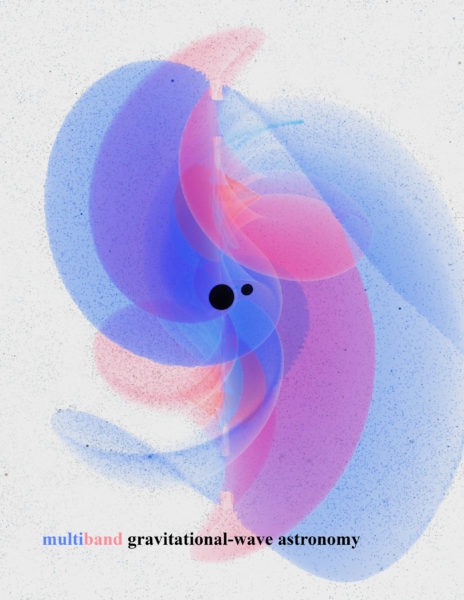Nov 19 2019
Black holes have always been mysterious from the time they were discovered. They continue to be one of the most breathtaking enigmas in the universe.
 A snapshot of the 3D gravitational waveform from a general relativistic simulation of binary black holes. Gravitational waves from such binary mergers are routinely observed by LIGO. With space missions such as LISA, the evolution of these binaries can be monitored years in advance, allowing multi-frequency constraints on astrophysical formations and tests of general relativity. Image Credit: Jani, K., Kinsey, M., Clark, M., Center for Relativistic Astrophysics, Georgia Institute of Technology.
A snapshot of the 3D gravitational waveform from a general relativistic simulation of binary black holes. Gravitational waves from such binary mergers are routinely observed by LIGO. With space missions such as LISA, the evolution of these binaries can be monitored years in advance, allowing multi-frequency constraints on astrophysical formations and tests of general relativity. Image Credit: Jani, K., Kinsey, M., Clark, M., Center for Relativistic Astrophysics, Georgia Institute of Technology.
In the recent past, several researchers have achieved greater heights in gaining insights into black holes using observational astronomy and an emerging area called gravitational wave astronomy, first proposed by Albert Einstein, which involves direct measurement of the gravitational waves radiated by black holes.
With the help of these insights into black hole gravitational waves, which were initially observed by the Laser Interferometer Gravitational-Wave Observatories (LIGO) in Louisiana and Washington in 2015, scientists have obtained exhilarating understanding about these invisible objects and created projections and theories on everything from their sizes to their physical properties.
However, drawbacks in LIGO and other observation technologies have hampered the effort of researchers to gain a comprehensive picture of black holes. Moreover, one of the widest gaps in knowledge is related to a specific type of black hole—those with intermediate-mass, or those that lie somewhere between supermassive (at least a million times greater than the sun) and stellar (although smaller, they are still 5 to 50 times greater than the mass of the sun).
This scenario could change soon, owing to a new study at Vanderbilt on the future course for gravitational wave astronomy. The research, headed by Vanderbilt astrophysicist Karan Jani and published recently as a letter in Nature Astronomy, introduces a convincing roadmap for capturing 4- to 10-year images of intermediate-mass black hole activity.
Like a symphony orchestra emits sound across an array of frequencies, the gravitational waves emitted by black holes occur at different frequencies and times. Some of these frequencies are extremely high-bandwidth, while some are low-bandwidth, and our goal in the next era of gravitational wave astronomy is to capture multiband observations of both of these frequencies in order to ‘hear the entire song’, as it were, when it comes to black holes.
Karan Jani, Astrophysicist, Vanderbilt University
Jani is a self-proclaimed “black hole hunter” who was named by Forbes in its 30 Under 30 list in Science for the year 2017. He was part of the group that observed the very first gravitational waves, and joined Vanderbilt in 2019 as a GRAVITY postdoctoral fellow.
In collaboration with researchers from Georgia Institute of Technology, California Institute of Technology, and the Jet Propulsion Laboratory at NASA, the new paper titled “Detectability of Intermediate-Mass Black Holes in Multiband Gravitational Wave Astronomy” discusses the future of LIGO detectors together with the proposed Laser Interferometer Space Antenna (LISA) space-mission.
This mission would help researchers reach one step closer to gaining insights into what happens in and around black holes.
The possibility that intermediate mass black holes exist but are currently hidden from our view is both tantalizing and frustrating. Fortunately, there is hope as these black holes are ideal sources for future multiband gravitational wave astronomy.
Deidre Shoemaker, Study Co-Author and Professor, School of Physics, Georgia Institute of Technology
A mission collaboratively operated by the European Space Agency and NASA, LISA is scheduled for launch in 2034, and would optimize detection sensitivity for low-frequency gravitational waves.
LISA is the first dedicated space-based gravitational wave detector that would offer a crucial measurement of a so far unachievable frequency and facilitate a more comprehensive detection of intermediate-mass black holes. In 2018, NASA appointed Kelly Holley-Bockelmann, a physics and astronomy professor at Vanderbilt, as the inaugural chair of the LISA Study Team.
Inside black holes, all known understanding of our universe breaks down. With the high frequency already being captured by LIGO detectors and the low frequency from future detectors and the LISA mission, we can bring these data points together to help fill in many gaps in our understanding of black holes.
Deidre Shoemaker, Study Co-Author and Professor, School of Physics, Georgia Institute of Technology
The study was partially supported by NASA (grant 80NSSC19K0322) and the National Science Foundation (grant PHY-1806580, PHY-1809572, and PHY-1708212). The research was performed at the Jet Propulsion Laboratory, California Institute of Technology, under contract with NASA.
Vanderbilt astrophysicist plans to observe a “cosmic symphony” using gravitational wave astronomy
New research led by Vanderbilt astrophysicist Karan Jani presents a compelling roadmap for capturing intermediate-mass black hole activity. Video Credit: Vanderbilt University.